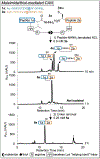Selective Activation of Peptide-Thioester Precursors for Templated Native Chemical Ligations
- PMID: 39198217
- PMCID: PMC11913120
- DOI: 10.1002/anie.202413644
Selective Activation of Peptide-Thioester Precursors for Templated Native Chemical Ligations
Abstract
Chemical protein synthesis enables access to proteins that would otherwise be difficult or impossible to obtain with traditional means such as recombinant expression. Chemoselective ligations provide the ability to join peptide segments prepared by solid-phase peptide synthesis. While native chemical ligation (NCL) is widely used, it is limited by the need for C-terminal thioesters with suitable reaction kinetics, properly placed native Cys or thiolated derivatives, and peptide segment solubility at low mM concentrations. Moreover, repetitive purifications to isolate ligated products are often yield-sapping, hampering efficiency and progress. In this work, we demonstrate the use of Controlled Activation of Peptides for Templated NCL (CAPTN). This traceless multi-segment templated NCL approach permits the one-pot synthesis of proteins by harnessing selective thioester activation and orthogonal conjugation chemistries to favor formation of the full-length ligated product while minimizing side reactions. Importantly, CAPTN provides kinetic enhancements allowing ligations at sterically hindered junctions and low peptide concentrations. Additionally, this one-pot approach removes the need for intermediate purification. We report the synthesis of two E. coli ribosomal subunits S16 and S17 enabled by the chemical tools described herein. We anticipate that CAPTN will expedite the synthesis of valuable proteins and expand on templated approaches for chemical protein synthesis.
Keywords: chemical protein synthesis; native chemical ligation; peptide conjugation; peptide-thioester precursor; templated peptide ligation.
© 2024 The Authors. Angewandte Chemie International Edition published by Wiley-VCH GmbH.
Conflict of interest statement
Conflict of Interest
The authors declare no conflict of interest.
Figures





Similar articles
-
Native Chemical Ligation via N-Acylurea Thioester Surrogates Obtained by Fmoc Solid-Phase Peptide Synthesis.Methods Mol Biol. 2020;2133:141-161. doi: 10.1007/978-1-0716-0434-2_7. Methods Mol Biol. 2020. PMID: 32144666
-
Automated Fmoc-based solid-phase synthesis of peptide thioesters with self-purification effect and application in the construction of immobilized SH3 domains.J Am Chem Soc. 2010 Aug 18;132(32):11110-8. doi: 10.1021/ja101732a. J Am Chem Soc. 2010. PMID: 20662535
-
Peptide Weinreb amide derivatives as thioester precursors for native chemical ligation.Org Biomol Chem. 2017 Mar 28;15(12):2491-2496. doi: 10.1039/c7ob00103g. Epub 2017 Feb 7. Org Biomol Chem. 2017. PMID: 28170021
-
Templated native chemical ligation: peptide chemistry beyond protein synthesis.J Pept Sci. 2014 Feb;20(2):78-86. doi: 10.1002/psc.2602. Epub 2014 Jan 7. J Pept Sci. 2014. PMID: 24395765 Review.
-
Ligation-desulfurization: a powerful combination in the synthesis of peptides and glycopeptides.Biopolymers. 2010;94(4):551-9. doi: 10.1002/bip.21442. Biopolymers. 2010. PMID: 20593472 Review.
References
-
- de Lisle Milton RC, Milton SCF, Schnölzer M, Kent SBH, in Tech. Protein Chem. IV (Ed.: Angeletti RH), Academic Press, 1993, pp. 257–267;
- Weinstock MT, Jacobsen MT, Kay MS, Proc. Natl. Acad. Sci. USA 2014, 111, 11679–11684; - PMC - PubMed
- Wang Z, Xu W, Liu L, Zhu TF, Nat. Chem. 2016, 8, 698–704; - PubMed
- Jiang W, Zhang B, Fan C, Wang M, Wang J, Deng Q, Liu X, Chen J, Zheng J, Liu L, Zhu TF, Cell Discovery 2017, 3, 17037; - PMC - PubMed
- Pech A, Achenbach J, Jahnz M, Schülzchen S, Jarosch F, Bordusa F, Klussmann S, Nucleic Acids Res. 2017, 45, 3997–4005; - PMC - PubMed
- Fan C, Deng Q, Zhu TF, Nat. Biotechnol. 2021, 39, 1548–1555; - PubMed
- Xu Y, Zhu TF, Science 2022, 378, 405–412; - PubMed
- Zhang G, Zhu TF, Nat. Chem. 2024. - PubMed
-
- Schumacher TN, Mayr LM, Minor DL Jr., Milhollen MA, Burgess MW, Kim PS, Science 1996, 271, 1854–1857; - PubMed
- Clinton TR, Weinstock MT, Jacobsen MT, Szabo-Fresnais N, Pandya MJ, Whitby FG, Herbert AS, Prugar LI, McKinnon R, Hill CP, Welch BD, Dye JM, Eckert DM, Kay MS, Protein Sci. 2015, 24, 446–463; - PMC - PubMed
- Petersen ME, Jacobsen MT, Kay MS, Org. Biomol. Chem. 2016, 14, 5298–5303; - PMC - PubMed
- Levinson AM, McGee JH, Roberts AG, Creech GS, Wang T, Peterson MT, Hendrickson RC, Verdine GL, Danishefsky SJ, J. Am. Chem. Soc. 2017, 139, 7632–7639; - PMC - PubMed
- Zhou X, Zuo C, Li W, Shi W, Zhou X, Wang H, Chen S, Du J, Chen G, Zhai W, Zhao W, Wu Y, Qi Y, Liu L, Gao Y, Angew. Chem. Int. Ed. 2020, 59, 15114–15118; - PubMed
- Callahan AJ, Gandhesiri S, Travaline TL, Reja RM, Lozano Salazar L, Hanna S, Lee Y-C, Li K, Tokareva OS, Swiecicki J-M, Loas A, Verdine GL, McGee JH, Pentelute BL, Nat. Commun. 2024, 15, 1813. - PMC - PubMed
-
- Lechner CC, Agashe ND, Fierz B, Angew. Chem. Int. Ed. 2016, 55, 2903–2906; - PubMed
- Mali SM, Singh SK, Eid E, Brik A, J. Am. Chem. Soc. 2017, 139, 4971–4986; - PubMed
- Jbara M, Laps S, Morgan M, Kamnesky G, Mann G, Wolberger C, Brik A, Nat. Commun. 2018, 9, 3154; - PMC - PubMed
- Ai H, Chu G-C, Gong Q, Tong Z-B, Deng Z, Liu X, Yang F, Xu Z, Li J-B, Tian C, Liu L, J. Am. Chem. Soc. 2022, 144, 18329–18337. - PubMed
MeSH terms
Substances
Grants and funding
LinkOut - more resources
Full Text Sources
Miscellaneous

